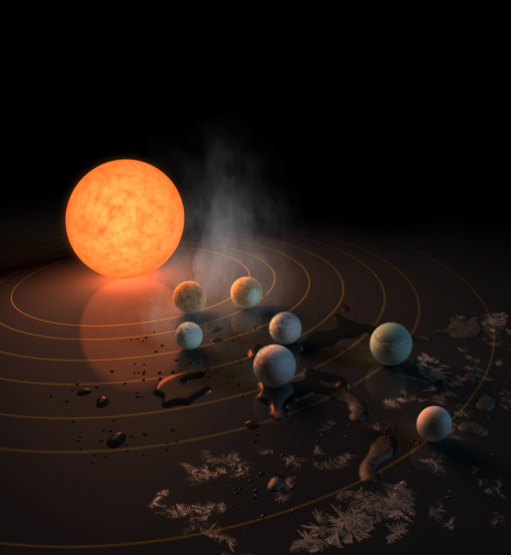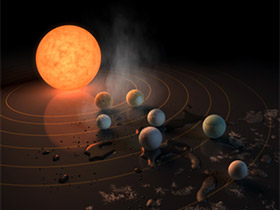 On February 22, 2017, NASA announced that the Spitzer Space Telescope discovered 7 planets around a star 39 light-years away named TRAPPIST-1. It was claimed that three of these planets in particular have the so-called necessary conditions for life, and that these planets might have been host to the evolutionary process. Based on this claim, many media outlets, especially the The Telegraph, of England, reported on the discovery. But these were sensational headlines that are completely devoid of scientific evidence, and specifically published to attract readers' attention. When we look at a few paragraphs below the headline, it becomes clear that there is no evidence supporting the so-called evolution of life on the newly discovered planets. Let's examine the reasons why there can't be life on these planets one by one.
On February 22, 2017, NASA announced that the Spitzer Space Telescope discovered 7 planets around a star 39 light-years away named TRAPPIST-1. It was claimed that three of these planets in particular have the so-called necessary conditions for life, and that these planets might have been host to the evolutionary process. Based on this claim, many media outlets, especially the The Telegraph, of England, reported on the discovery. But these were sensational headlines that are completely devoid of scientific evidence, and specifically published to attract readers' attention. When we look at a few paragraphs below the headline, it becomes clear that there is no evidence supporting the so-called evolution of life on the newly discovered planets. Let's examine the reasons why there can't be life on these planets one by one.
1. The definition of the alleged "Habitable Zone" is not sufficient for life
Three of the newly discovered planets have been described as being on the "Habitable Zone" in NASA's statement. What should then be the conditions of this "Habitable Zone", which is also called as the window of life? In order to understand this, it is enough to examine our world, which is created with ideal standards. For example, in order to have "carbon-based" life on Earth, it is necessary for the temperature to remain between very sensitive values. The proteins of humans and many other living beings become denatured and lose their vital properties after 430C. Even though some microorganisms can withstand temperatures of 120-1300C for a while, they can't sustain this for a long time. Again, while many living beings lose their vital properties due to freezing temperatures below 00C, only a few can persist in these temperatures by slowing down their vital activities. In order for their vital activities to return to normal, it is necessary for temperature to be above 00C. In short, in a universe where we encounter varying temperature values between minus 2730 C and millions of degrees, the preservation of very small temperature values of a few tens of degrees without major changes is imperative for the existence and continuation of carbon based life. It is also important that these values correspond to the value at which water remains as liquid. A zone in which these values, which can be characterized as window of life, can be achieved is called the "Habitable Zone".
The habitable zone is absolutely necessary for the existence of life; but that alone cannot be enough in any case. When we consider the conditions on Earth, there are scores of scientifically proven, maybe even hundreds more “absolute must” features that we haven't yet noticed beyond the temperature balance. The absence or disappearance of any one of the many features such as the presence of the atmosphere, its thickness, its gas composition, the speed of the Earth's rotation, the water balance, the magnetic shield, the Moon's presence, and many more, means that life can never exist on Earth or can disappear suddenly.
The supposition that "planets in which life can exist are discovered" is a populist approach to divert people's attention away from scientific facts. NASA's discovery is simply the discovery of some planets with habitable zone temperature values. However, as briefly mentioned above, the presence and continuation of life require the presence of very sensitive values.
2. The conditions on these newly discovered planets do not resemble Earth
These planets that are reported with presumptuous remarks like "new Earths are found in space", in fact have no common features with the Earth except their temperature values and dimensions.
TRAPPIST-1, for example, is a very small and dim star compared to our Sun. Compared to the Sun, it gives 200 times less heat and light. The surface temperature of the Sun is 5778 K, while TRAPPIST-1 has a temperature of 2550 K. So it only provides a twilight-like brightness.
The reason why these planets have similar temperature values to Earth despite this low energy emission is that these planets have closer orbits around their star. These newly discovered planets are even closer to TRAPPIST-1 than Mercury, the closest planet to the Sun. As a result, the time it takes for them to rotate around their star is also very short. The time it takes for the planet closest to the star to rotate around TRAPPIST-1 is only 1.5 days, and it takes 18.8 days for the farthest sixth planet to fully rotate around TRAPPIST-1.
The distances between these seven planets are also very short; some of them are even closer to each other than Earth's distance from the Moon.
As it turns out, in fact, these planets have nothing in common with Earth's conditions. The fact that they have very fast orbits and are very close to each other are features that will make the surface conditions of the planets quite different. Under these circumstances, no feature that can enable the existence of life shows any similarity to Earth other than the fact that the water that may exist on the planets can remain in liquid state.
3. There is no evidence for the existence of life on these planets
No findings have been discovered about the existence of conditions suitable for life other than the temperature, on the newly discovered planets. Also, there is thus far no data suggesting the existence of water on the planets, which is the most basic characteristic required by the habitable zone. Do the planets have atmospheres? If they have, do they contain oxygen? Does the surface of the planets have a solid crust suitable for life? While there is no information yet on any of these topics, claiming that these planets can be suitable for life based solely on similar temperature values is far from a scientific approach.
4. Mars and Venus are also in the alleged "Habitable Zone" but there is no life on those planets
In fact, there is no need to travel quite so far. Similar to the discovered planets that are claimed to be habitable, there are two more planets even more similar to Earth and close enough to us to be considered as our neighbors: Venus and Mars. But as we all know, there is no life on these planets.
It is believed that there was water on Venus in the past. However, because the planet does not have an Earth-like magnetosphere protection, it is heavily exposed to solar winds. For this reason, it is thought that hydrogen and oxygen atoms were scattered into space over time. Right now, there is only a small amount of water vapor in its atmosphere. Liquid water does not exist on the surface of Venus because its atmosphere, which consists of dense carbon dioxide, has raised the temperature above 4000C. As you can see, even the absence of the magnetic shield means that conditions that are necessary for life is not possible.
If we look at Mars on the other hand; its atmosphere is 100 times thinner than the Earth's atmosphere and 95% of its atmosphere consists of carbon dioxide. This causes the temperature to be unsustainable for life and day-night temperature differences to vary from 200C to minus 700C. The absence of oxygen and water are already known facts.
On both planets, many constituent factors such as the temperature level and the fact that it must be kept stable, must be precise. However, there is no data on these constituent factors obtained from the discovered planets. Moreover, It is also clear that even if all this data was known and fully viable for life, it is impossible for life to emerge through an evolutionary process based on coincidence.
Darwinists' way of escape: Searching for extraterrestrial life
The darkest point of the theory of evolution is the origin of life. No scientific evidence has been found as yet about how the first cell came into being. Evolutionist scientists can't even hypothesize about how the first cell came into being, let alone finding concrete evidence. Thus, an idea was asserted as the ultimate hope to keep the theory of evolution alive: "Life has come from space." Based on such suppositions, it would be easier for the evolutionists to camouflage their non-scientific explanations once they would search for the origin of life in space where it is difficult to collect evidence.
Evolutionists can't even explain how life emerged on Earth where conditions are convenient and every place is bursting with life. Nevertheless, the fact that evolutionists claim "there may be life on newly discovered planets" based solely on the fact that the planets are in a zone with appropriate temperature levels, shows how non-scientific their approach is. With this supposition, evolutionists try to consolidate the nonsense that life came from space. However, they know very well that any carbon-based life similar to one on Earth cannot form on those planets. But, because accepting this means the refutation of both themselves and their ideology, they would never admit it.
Downplaying the origin of life, meaning the existence of life as if it is an easy process to occur is an evolutionist perception operation carried out on public opinion. By giving the impression that life can occur even under very simple conditions to people who do not have enough knowledge on the subject, evolutionists try to keep the miraculous aspect of life hidden. However, the existence of life and its continuation necessitates the many of the above-mentioned absolute must conditions to be present at the same time. All this delicate order and perfection can never be explained by coincidence.
God may create life everywhere and in every circumstance
God may bring about life in every environment by creating the appropriate conditions. The thing we criticize and explain the impossibility of here is the non-scientific and biased approach of evolutionists. While in the light of scientific data it is clear that carbon-based life similar to one on Earth is impossible to exist in the TRAPPIST-1 system, it is a great blunder to try confusing the minds of the public with evolutionist fallacies. If God wills it, life can be created in every circumstance.
Say: ‘He (God) Who made them in the first place will bring them back to life. He has total knowledge of each created thing." (Surah Ya Sin, 79)
Sources:
- www.nasa.gov/press-release/nasa-telescope-reveals-largest-batch-of-earth-size-habitable-zone-planets-around
- http://www.telegraph.co.uk/science/2017/02/22/nasa-announcement-live/


